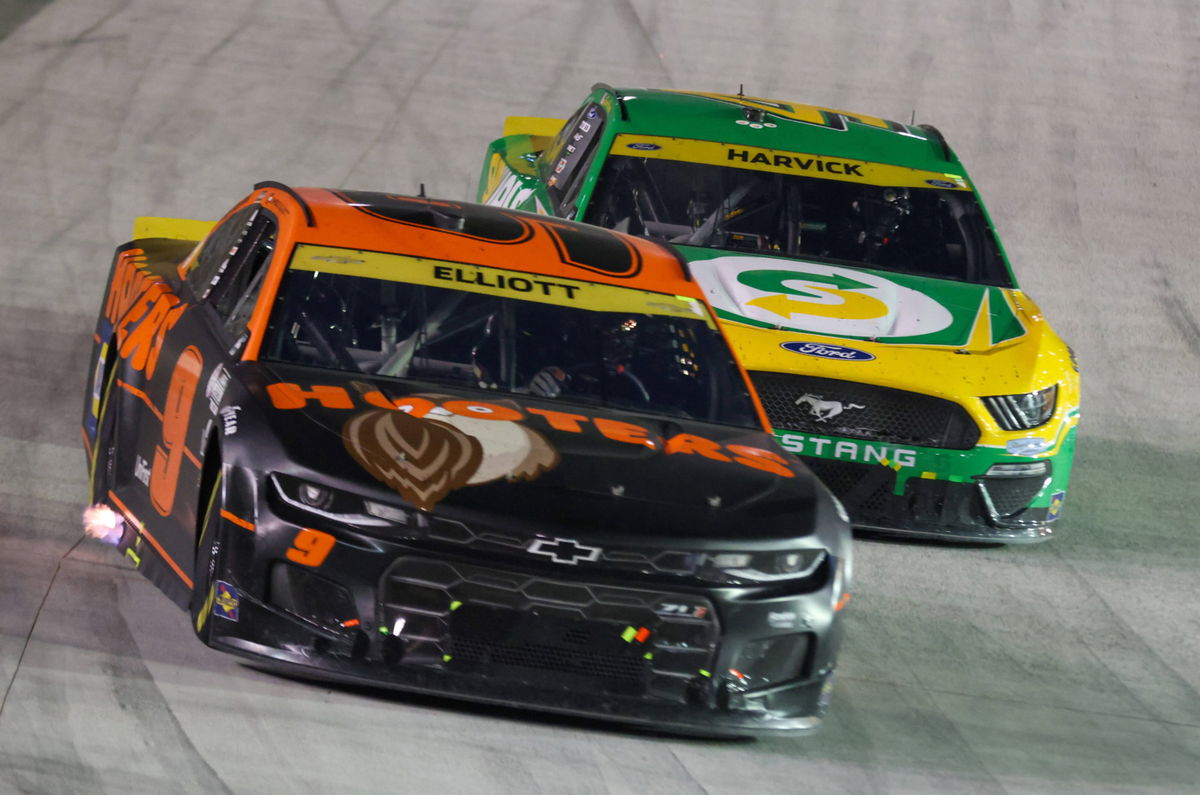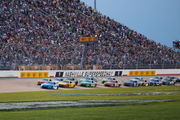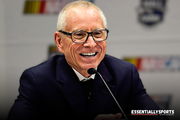
USA Today via Reuters
NASCAR, Motorsport, USA Bass Pro Shops Night Race, Sep 18, 2021 Bristol, Tennessee, USA NASCAR Cup Series driver Chase Elliott 9 and driver Kevin Harvick 4 compete during the race at Bristol Motor Speedway. Mandatory Credit: Randy Sartin-USA TODAY Sports, 18.09.2021 22:43:23, 16783977, Nascar, Bristol Motor Speedway, Chase Elliott, Kevin Harvick PUBLICATIONxINxGERxSUIxAUTxONLY Copyright: xRandyxSartinx 16783977

USA Today via Reuters
NASCAR, Motorsport, USA Bass Pro Shops Night Race, Sep 18, 2021 Bristol, Tennessee, USA NASCAR Cup Series driver Chase Elliott 9 and driver Kevin Harvick 4 compete during the race at Bristol Motor Speedway. Mandatory Credit: Randy Sartin-USA TODAY Sports, 18.09.2021 22:43:23, 16783977, Nascar, Bristol Motor Speedway, Chase Elliott, Kevin Harvick PUBLICATIONxINxGERxSUIxAUTxONLY Copyright: xRandyxSartinx 16783977
The final laps at Michigan this year felt like a throwback to a different era in NASCAR. Not one ruled by horsepower or stage wins, but one ruled by calculators, crew chiefs’ whispers, and quiet confidence. As fans watched, Denny Hamlin didn’t charge past his rivals with brute speed; he simply waited. With four laps to go, he passed a sputtering William Byron, whose dominant day was undone by an empty tank. Hamlin, known for closing strong, claimed his third win of the season and 57th of his Cup career by doing what few dared, backing off the throttle to win the race.
Watch What’s Trending Now!
It was a clinic in patience and strategy. While Byron had led 98 laps and looked unbeatable, Hamlin saved fuel, stayed close, and let the race come to him. “I wanted to get the lead, and obviously he [William Byron] was doing a really good job defending. Sorry, but I beat your favorite driver,” said Denny Hamlin post-race. But the JGR driver’s win wasn’t purely luck-based. He trusted the numbers, trusted the process, and trusted his team. When the No. 24 pulled off for a splash of gas, Hamlin’s calm approach lit up the grandstands.
That finish wasn’t just a win; it was a signal. A shift and a reminder that in 2025, NASCAR isn’t just about speed. It’s about smarts. It’s about knowing when to push and when to coast. And it raises a sharp question across pit road and fan forums alike: Is the new path to victory fuel strategy, or is raw speed still king?
ADVERTISEMENT
Fuel Strategy vs. Flat-out speed—The new NASCAR debate
Across the garage this season, a clear theme is forming: fuel strategy is back in fashion. It’s not just Michigan. Races like Las Vegas and even Daytona showed teams conserving fuel early to gamble late. At Michigan, the final 49 laps ran green. Every driver had to make a choice: chase the leader or conserve and survive. Denny Hamlin did both. The pros are clear. Fuel strategy brings unpredictability. No one is safe.
A driver like William Byron can dominate all day and finish 28th. Hamlin led only the most important laps, the final ones. That kind of drama keeps fans glued to the finish. It also forces drivers to adapt. Some, like Ty Gibbs, struggle with that. “I was going to go until we ran out. I think a win is more important than third,” Gibbs said. But his team played it safe, and they finished third instead. Notably, fuel races used to be common. But the Next Gen car and stage racing have pushed teams toward aggressive, all-out runs.
ADVERTISEMENT
Hamlin has been on the other side of fuel fuel-saving race this year. Call it a coincidence or just a random occurrence, Hamlin and Byron were dueling at Charlotte a few weeks back. Both drivers hit pit road on Lap 348 of 400 and knew they would be stretching their chances with a quick stop. The #11 crew didn’t add enough fuel in their car, and thus Hamlin was 12 laps short, and he was hoping for a late race caution, which never came. He had to relinquish the chase on the #24 car and head back for fuel, resulting in a 16th-place finish. Clearly, there’s a new trend on the Intermediate racetrack along with Superspeedways.
Never change, @dennyhamlin. 😂 pic.twitter.com/BJFwUrBtd6
— NASCAR (@NASCAR) June 8, 2025
ADVERTISEMENT
Sunday’s race reminded fans of 2009’s wild Michigan finish, when fuel miscalculations handed victory to those who conserved. The race saw Mark Martin take home the win after Jimmie Johnson and Greg Biffle ran out of gas in the closing laps. Now, in 2025, it’s becoming clear that kind of drama is back. But fans are divided. On Reddit and X, reactions ranged from thrilled to frustrated. One fan posted: “Finally! A race where the winner didn’t just have the best car, he had the best brain.” Another countered: “Saving gas for 20 laps? That’s not racing, that’s math class.”
Both have a point. And the data backs it. In Las Vegas, teams faced a similar scenario. Crew chiefs were caught between pitting under green or risking it all. Cliff Daniels, Larson’s crew chief, admitted: “If I would have stayed out, we were going to be with the guys that ended up making it on fuel. In the fall, we could have had a top-three finish, and today, it went the exact opposite.” That’s how close it gets. The strategy doesn’t always work, but when it does, it can win you the race. Or lose it. Ask Joey Logano, who gambled at Las Vegas and came up empty.
Top Stories
Dale Jr. Warns of Deeper Issues as Joe Gibbs Parts Ways With Decade-Long Executive

Chase Elliott’s Popularity Hits New Low as Dale Jr.’s Daytona 500 Return Triggers Record-Breaking Sale

Concerned NASCAR Fans Raise Red Flags Over Safety Issues Ahead of the Daytona 500

NASCAR Faces Uncomfortable Reality as Grassroot Racing Series Rejects Its Formula, Claims Insider

Exclusive: Mark Martin’s Career Philosophy in Both Racing and Life — “Never Lift”

ADVERTISEMENT
Finding the balance is important!
However, there is a downside. Fuel strategy can feel passive. Drivers coast. They don’t chase. That’s a hard sell to casual fans. But when the strategy pays off, the payoff is massive. Just ask Denny Hamlin. Just ask William Byron, watching his near-certain win evaporate on pit road. Data backs it up. Amazon Prime’s “Burn Bar” graphics showed fans just how razor-thin the margins were. Byron burned too much, too early.
Hamlin and Ty Gibbs throttled back just enough. Both finished in the top three. That difference wasn’t about engines. It was about choices. Crew chiefs now face impossible decisions. Gamble and stay out? Or pit for security and risk falling behind? As drivers hate holding back, it is up to them to make it count. The problem lies in balance. Strategy is exciting, but not if it takes over the whole race.
The Next Gen car plays a role, too, in modern NASCAR races. With minimal tire wear and reduced passing, saving fuel might be the only variable left. The tire doesn’t fall off like it used to. That’s made tracks like Martinsville and Richmond feel “like parade laps,” as one fan wrote online. That’s why Michigan felt different. It had stakes. With Carson Hocevar up front, looking for his first win, fans were engaged. Then a flat tire ruined his day. Then Byron ran out. The race flipped fast. That’s the kind of thrilling action fans want.
ADVERTISEMENT
What fans seem to want is balance. A race that starts with pace but ends with a puzzle. At Michigan, we got both. As NASCAR eyes the playoffs and even international races like Mexico City, teams are doubling down on strategy. You can’t just build a fast car anymore. You have to build a smart race. And in 2025, the smartest teams are the ones rewriting the playbook.
ADVERTISEMENT
ADVERTISEMENT
ADVERTISEMENT

